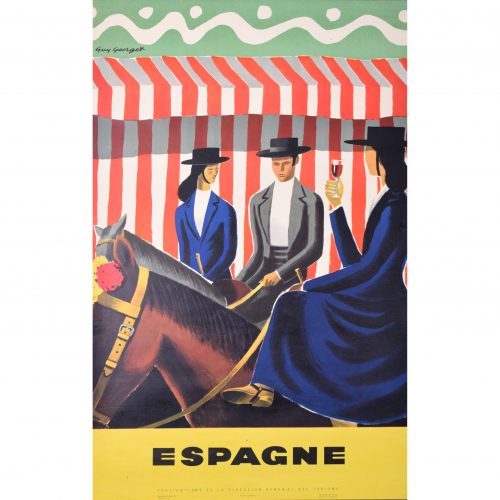-
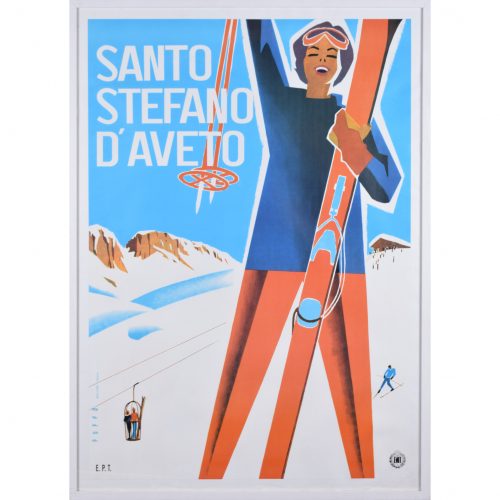
Mario Puppo (1905 - 1977)
Santo Stefano d'Aveto
Original vintage poster 97 x 68 cm Produced circa 1955 for Italian Railways. Mario Puppo's poster advertising the Italian ski resort of Santo Stefano d'Aveto. The figure of a skier reaches upward in triumph; behind her, a vintage ski lift makes its way up the mountain and a blue-clad skier tackles the piste. Mario Puppo was born in Levanto, Italy, and worked in a studio in Chiavari. He designed leaflets advertising skiing and beach resorts, which gained popularity in the 1930s. By the 1940s his poster designs were being featured in the Milan Advertising Graphics show. Throughout the 1940s he designed covers for catalogues, leaflets, playbills, music scores and records, as well as producing more travel posters for public and private Italian companies. Condition: backed to linen; frame included for UK mainland only (excluding Cornwall, Highlands and Islands - where further shipping charges may apply). If you are interested, please email info@manningfineart.co.uk or call us on 07929 749056. Click here for more original vintage posters. -
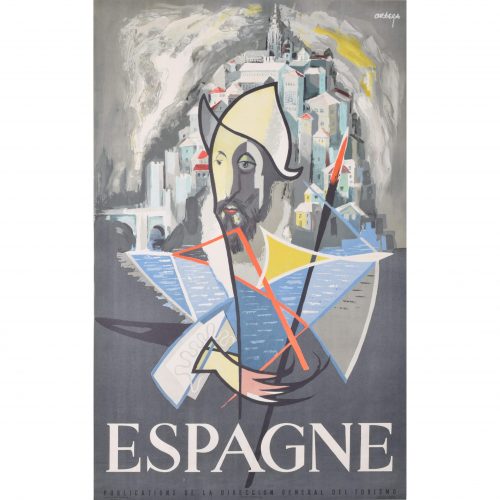
José Ortega (1921 - 1990)
"Don Quixote" Espagne
Original vintage poster c. 1960 99 x 65 cm Printed in Barcelona for the Publications de la Direccion General del Turismo. Ortega's poster is an abstract depiction Don Quixote (the Spanish hero written by Miguel de Cervantes), complete with his distinctive hat and spear. Ortega designed the poster for the Spanish tourist board, using an illustrious figure from Spain's literary heritage to encourage people to visit Spain. José García Ortega was born in Arroba de los Montes and was a member of the Communist Party. He worked as a painter and sculptor, studying at the Círculo de Bellas Artes in Madrid. In 1953 he went to France to study art, funded by a French government scholarship. He returned to Spain throughout the 1950s and 1960s, and became a commercially successful artist. Some of his most famous designs include the posters which the Spanish tourist board commissioned from him circa 1960. Condition: generally very good. If you are interested, please email info@manningfineart.co.uk or call us on 07929 749056. Click here for more original vintage travel posters. -
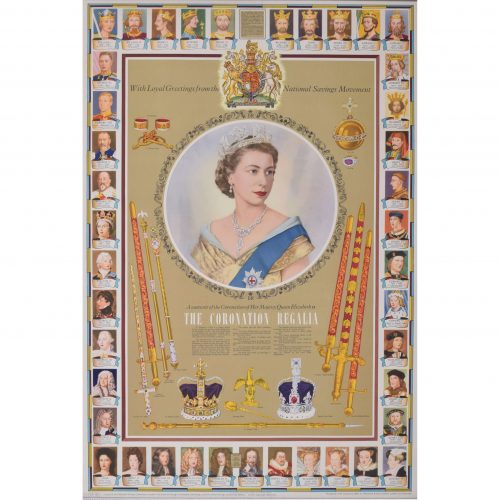
after Dorothy Wilding (1893 - 1976)
The Coronation Regalia (1953)
Original vintage poster 75 x 50 cm Issued by the National Savings Committee, London, the Scottish Savings Committee, Edinburgh, and the Ulster Savings Committee, Belfast. Crown Copyright Reserved. Printed for H.M. Stationery Office by Waterloo & Sons Limited, London and Dunstable. A fantastic piece of royalist British history. The famous portrait photographer Dorothy Wilding captured Queen Elizabeth II at her Coronation in 1952 - the photograph, used as the centrepiece of this poster, was also used on Britain's postage stamps until 1967. This particular poster was designed to be a Coronation souvenir, and features all the regalia and trappings of the United Kingdom's coronation ceremony, including crown, sword, orb, and sceptres, to name a few. The poster's margins are decorated with portraits of Britain's monarchs past, dating back to William the Conqueror. The National Savings Movement was a government-backed savings movement which began during the First World War to finance the government's wartime deficit. Savings products promoted by the movement typically offered a low level of return but the safety of a government guarantee. Various poster designs were issued by the movement to encourage ordinary people to save - we have several different designs in stock. Condition: generally very good. If you are interested, please email info@manningfineart.co.uk or call us on 07929 749056. Click here for other National Savings posters. -
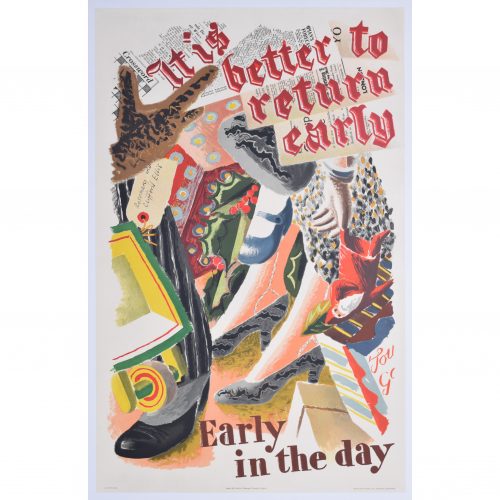
Clifford and Rosemary Ellis
It Is Better To Return Early
Lithographic poster 102 x 61 cm Printed by Waterlow & Sons Ltd for London Transport. This original vintage poster was designed for London Transport and encourages shoppers to head home earlier in the day to avoid congestion on the London Underground and buses. The well-heeled customers in the poster sport smart 1930s shoes, and jostle against their purchases (a Father Christmas puppet and red-berried holly leaves mark the design as published in time for Christmas). The pinstripe-suited gentleman's newspaper serves as the background for the first line of the poster's text, which is slanted in the synthetic cubist style (synthetic cubists were keen to explore collage in their work, often employing collage, especially of newsprint). London Transport was the forerunner of London Underground. During the 1930s London Transport commissioned over forty posters a year from well-known artists such as Laura Knight, CRW Nevinson, Edward Wadsworth, Eric Ravilious, Paul Nash, Graham Sutherland, and Edward McKnight Kauffer – a bold policy that did much to popularise avant-garde artistic styles that stemmed from Cubism, Futurism and Abstraction. Condition: very good, backed to linen. If you are interested, please email info@manningfineart.co.uk or call us on 07929 749056. Click here for other works by Clifford and Rosemary Ellis. -
Out of stock
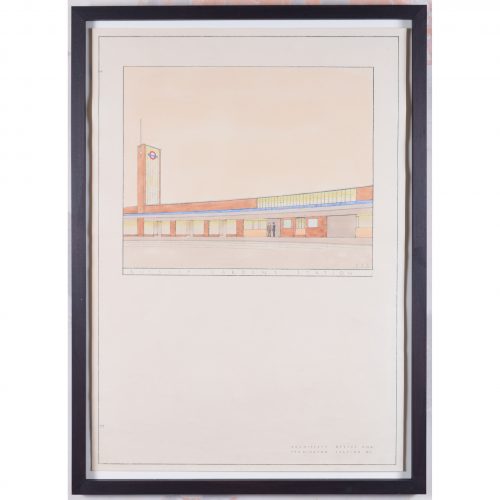
Brian Bannatyne Lewis (1906 - 1991)
Ruislip Gardens Station (1938)
Pen, ink and watercolour 70 x 50 cm Initialled and dated 4 3 38. A 1938 design for the new Ruislip Gardens tube station, commissioned by the Great Western Railway (GWR) for its proposed western extension to the Central Line. The design's Art Deco lettering befits London Transport's aesthetic in the 1930s. Lewis brings his designs to life by including smartly-dressed characters entering and leaving the stations. Ruislip Gardens Station, when built, did not adhere to this design. The Central line opened in 1900, between Shepherd's Bush and Bank; it extended westwards to Ealing Broadway in 1920. Two years after the formation of London Transport in 1933, an extensive New Works Programme began, proposing a westwards extension of the line to Denham. Brian Lewis created designs for nine stations in early 1938, but the Second World War broke out before they could be built. By the time the extension had been built, Lewis was no longer chief architect of the GWR - the stations were modified and completed by Frederick Francis Charles Curtis instead. The extension to Greenford opened in 1947 and finally reached West Ruislip in 1948. Denham never actually became part of the tube line, owing to the establishment of the green belt. Brian Lewis was born in Tasmania, attended school in Melbourne, and subsequently obtained a Diploma in Architecture in 1928 from the University of Melbourne. He then moved to the UK to study at the Liverpool School of Architecture, winning scholarships in each of his three years of study to fund extensive European travel. He married a fellow Liverpool architectural student, Hilary Archer. After moving to London, he took up employment with the GWR in their architects’ office; he also lectured at a local polytechnic, and moonlighted with his wife at home on mainly residential commissions – rather different projects from the hotels and stations which GWR commissioned from him. He exhibited frequently at the Royal Academy of Arts, showing superb measured drawings of historic buildings. In the Second World War he enlisted with the Second Imperial Australian Force, serving in the Middle East, then transferred to the Royal Australian Engineers where he became a Captain. In 1943 he was sent to London to help GWR repair bomb damage. Lewis became Chief Architect of GWR in 1945 (following the retirement of the noted Percy Emerson Culverhouse), and the first Chair of Architecture at Melbourne University in 1947. He also became the consulting architect for the major buildings of the Australian National University in Canberra, producing an imaginative site plan and designing University House, which was awarded the Sulman medal in 1954. He also designed the Risdon Prison Complex in 1960. He retired in 1971 to paint watercolours and write his memoirs. Condition: generally very good; a few handling marks and two holes from filing. Handsomely framed. If you are interested, please email info@manningfineart.co.uk or call us on 07929 749056. Click here to view the other station designs in the set. -
Out of stock
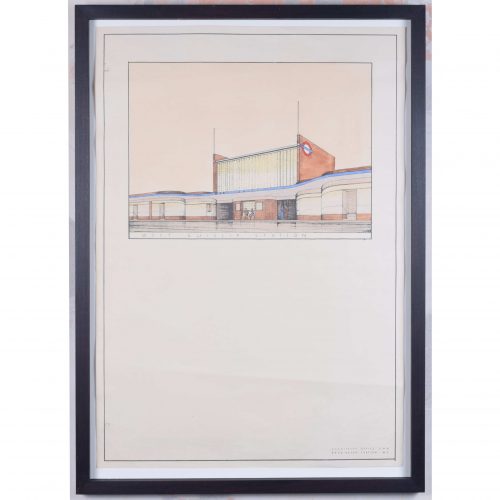
Brian Bannatyne Lewis (1906 - 1991)
West Ruislip Station (1938)
Pen, ink and watercolour 70 x 50 cm A 1938 design for the new West Ruislip tube station, commissioned by the Great Western Railway (GWR) for its proposed western extension to the Central Line. The design's Art Deco lettering befits London Transport's aesthetic in the 1930s. Lewis brings his designs to life by including smartly-dressed characters entering and leaving the stations. The Central line opened in 1900, between Shepherd's Bush and Bank; it extended westwards to Ealing Broadway in 1920. Two years after the formation of London Transport in 1933, an extensive New Works Programme began, proposing a westwards extension of the line to Denham. Brian Lewis created designs for nine stations in early 1938, but the Second World War broke out before they could be built. By the time the extension had been built, Lewis was no longer chief architect of the GWR - the stations were modified and completed by Frederick Francis Charles Curtis instead. The extension to Greenford opened in 1947 and finally reached West Ruislip in 1948. Denham never actually became part of the tube line, owing to the establishment of the green belt. Brian Lewis was born in Tasmania, attended school in Melbourne, and subsequently obtained a Diploma in Architecture in 1928 from the University of Melbourne. He then moved to the UK to study at the Liverpool School of Architecture, winning scholarships in each of his three years of study to fund extensive European travel. He married a fellow Liverpool architectural student, Hilary Archer. After moving to London, he took up employment with the GWR in their architects’ office; he also lectured at a local polytechnic, and moonlighted with his wife at home on mainly residential commissions – rather different projects from the hotels and stations which GWR commissioned from him. He exhibited frequently at the Royal Academy of Arts, showing superb measured drawings of historic buildings. In the Second World War he enlisted with the Second Imperial Australian Force, serving in the Middle East, then transferred to the Royal Australian Engineers where he became a Captain. In 1943 he was sent to London to help GWR repair bomb damage. Lewis became Chief Architect of GWR in 1945 (following the retirement of the noted Percy Emerson Culverhouse), and the first Chair of Architecture at Melbourne University in 1947. He also became the consulting architect for the major buildings of the Australian National University in Canberra, producing an imaginative site plan and designing University House, which was awarded the Sulman medal in 1954. He also designed the Risdon Prison Complex in 1960. He retired in 1971 to paint watercolours and write his memoirs. Condition: generally very good; a few handling marks and two holes from filing. Handsomely framed. If you are interested, please email info@manningfineart.co.uk or call us on 07929 749056. Click here to view the other station designs in the set. -
Out of stock
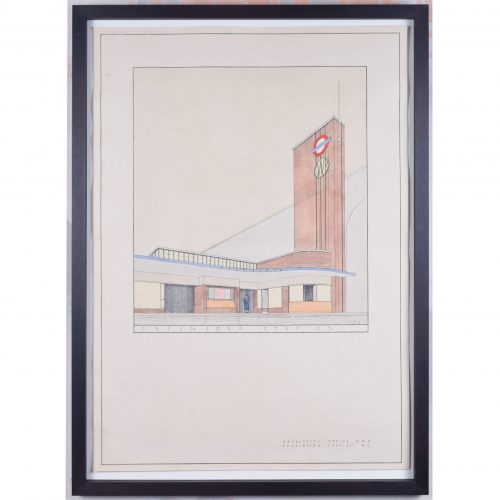
Brian Bannatyne Lewis (1906 - 1991)
Greenford Station (1938)
Pen, ink and watercolour 70 x 50 cm Initialled and dated 7 3 38. A 1938 design for the new Greenford tube station, commissioned by the Great Western Railway (GWR) for its proposed western extension to the Central Line. The design's Art Deco lettering befits London Transport's aesthetic in the 1930s. Lewis brings his designs to life by including smartly-dressed characters entering and leaving the stations. The Central line opened in 1900, between Shepherd's Bush and Bank; it extended westwards to Ealing Broadway in 1920. Two years after the formation of London Transport in 1933, an extensive New Works Programme began, proposing a westwards extension of the line to Denham. Brian Lewis created designs for nine stations in early 1938, but the Second World War broke out before they could be built. By the time the extension had been built, Lewis was no longer chief architect of the GWR - the stations were modified and completed by Frederick Francis Charles Curtis instead. The extension to Greenford opened in 1947 and finally reached West Ruislip in 1948. Denham never actually became part of the tube line, owing to the establishment of the green belt. Brian Lewis was born in Tasmania, attended school in Melbourne, and subsequently obtained a Diploma in Architecture in 1928 from the University of Melbourne. He then moved to the UK to study at the Liverpool School of Architecture, winning scholarships in each of his three years of study to fund extensive European travel. He married a fellow Liverpool architectural student, Hilary Archer. After moving to London, he took up employment with the GWR in their architects’ office; he also lectured at a local polytechnic, and moonlighted with his wife at home on mainly residential commissions – rather different projects from the hotels and stations which GWR commissioned from him. He exhibited frequently at the Royal Academy of Arts, showing superb measured drawings of historic buildings. In the Second World War he enlisted with the Second Imperial Australian Force, serving in the Middle East, then transferred to the Royal Australian Engineers where he became a Captain. In 1943 he was sent to London to help GWR repair bomb damage. Lewis became Chief Architect of GWR in 1945 (following the retirement of the noted Percy Emerson Culverhouse), and the first Chair of Architecture at Melbourne University in 1947. He also became the consulting architect for the major buildings of the Australian National University in Canberra, producing an imaginative site plan and designing University House, which was awarded the Sulman medal in 1954. He also designed the Risdon Prison Complex in 1960. He retired in 1971 to paint watercolours and write his memoirs. Condition: generally very good; a few handling marks and two holes from filing. Handsomely framed. If you are interested, please email info@manningfineart.co.uk or call us on 07929 749056. Click here to view the other station designs in the set. -
Out of stock
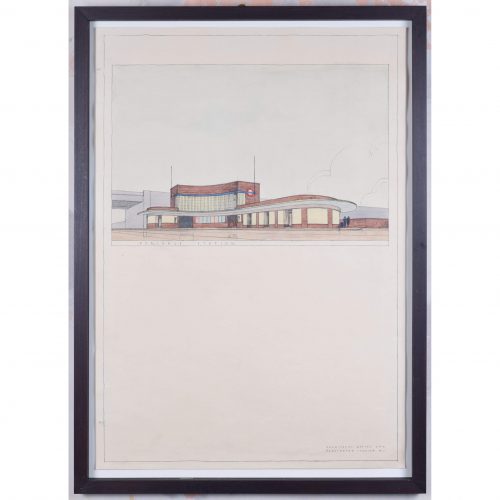
Brian Bannatyne Lewis (1906 - 1991)
Perivale Station (1938)
Pen, ink and watercolour 70 x 50 cm A 1938 design for the new Perivale tube station, commissioned by the Great Western Railway (GWR) for its proposed western extension to the Central Line. The design's Art Deco lettering befits London Transport's aesthetic in the 1930s. Lewis brings his designs to life by including smartly-dressed characters entering and leaving the stations. The Central line opened in 1900, between Shepherd's Bush and Bank; it extended westwards to Ealing Broadway in 1920. Two years after the formation of London Transport in 1933, an extensive New Works Programme began, proposing a westwards extension of the line to Denham. Brian Lewis created designs for nine stations in early 1938, but the Second World War broke out before they could be built. By the time the extension had been built, Lewis was no longer chief architect of the GWR - the stations were modified and completed by Frederick Francis Charles Curtis instead. The extension to Greenford opened in 1947 and finally reached West Ruislip in 1948. Denham never actually became part of the tube line, owing to the establishment of the green belt. Brian Lewis was born in Tasmania, attended school in Melbourne, and subsequently obtained a Diploma in Architecture in 1928 from the University of Melbourne. He then moved to the UK to study at the Liverpool School of Architecture, winning scholarships in each of his three years of study to fund extensive European travel. He married a fellow Liverpool architectural student, Hilary Archer. After moving to London, he took up employment with the GWR in their architects’ office; he also lectured at a local polytechnic, and moonlighted with his wife at home on mainly residential commissions – rather different projects from the hotels and stations which GWR commissioned from him. He exhibited frequently at the Royal Academy of Arts, showing superb measured drawings of historic buildings. In the Second World War he enlisted with the Second Imperial Australian Force, serving in the Middle East, then transferred to the Royal Australian Engineers where he became a Captain. In 1943 he was sent to London to help GWR repair bomb damage. Lewis became Chief Architect of GWR in 1945 (following the retirement of the noted Percy Emerson Culverhouse), and the first Chair of Architecture at Melbourne University in 1947. He also became the consulting architect for the major buildings of the Australian National University in Canberra, producing an imaginative site plan and designing University House, which was awarded the Sulman medal in 1954. He also designed the Risdon Prison Complex in 1960. He retired in 1971 to paint watercolours and write his memoirs. Condition: generally very good; a few handling marks and two holes from filing. Handsomely framed. If you are interested, please email info@manningfineart.co.uk or call us on 07929 749056. Click here to view the other station designs in the set. -
Out of stock
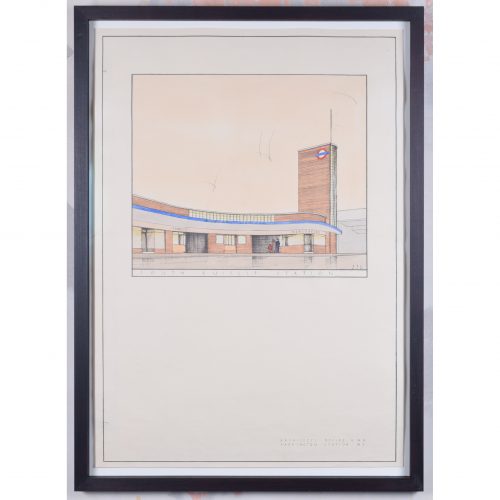
Brian Bannatyne Lewis (1906 - 1991)
South Ruislip Station (1938)
Pen, ink and watercolour 70 x 50 cm Initialled and dated 8 3 38. A 1938 design for the new South Ruislip tube station, commissioned by the Great Western Railway (GWR) for its proposed western extension to the Central Line. The design's Art Deco lettering befits London Transport's aesthetic in the 1930s. Lewis brings his designs to life by including smartly-dressed characters entering and leaving the stations. The Central line opened in 1900, between Shepherd's Bush and Bank; it extended westwards to Ealing Broadway in 1920. Two years after the formation of London Transport in 1933, an extensive New Works Programme began, proposing a westwards extension of the line to Denham. Brian Lewis created designs for nine stations in early 1938, but the Second World War broke out before they could be built. By the time the extension had been built, Lewis was no longer chief architect of the GWR - the stations were modified and completed by Frederick Francis Charles Curtis instead. The extension to Greenford opened in 1947 and finally reached West Ruislip in 1948. Denham never actually became part of the tube line, owing to the establishment of the green belt. Brian Lewis was born in Tasmania, attended school in Melbourne, and subsequently obtained a Diploma in Architecture in 1928 from the University of Melbourne. He then moved to the UK to study at the Liverpool School of Architecture, winning scholarships in each of his three years of study to fund extensive European travel. He married a fellow Liverpool architectural student, Hilary Archer. After moving to London, he took up employment with the GWR in their architects’ office; he also lectured at a local polytechnic, and moonlighted with his wife at home on mainly residential commissions – rather different projects from the hotels and stations which GWR commissioned from him. He exhibited frequently at the Royal Academy of Arts, showing superb measured drawings of historic buildings. In the Second World War he enlisted with the Second Imperial Australian Force, serving in the Middle East, then transferred to the Royal Australian Engineers where he became a Captain. In 1943 he was sent to London to help GWR repair bomb damage. Lewis became Chief Architect of GWR in 1945 (following the retirement of the noted Percy Emerson Culverhouse), and the first Chair of Architecture at Melbourne University in 1947. He also became the consulting architect for the major buildings of the Australian National University in Canberra, producing an imaginative site plan and designing University House, which was awarded the Sulman medal in 1954. He also designed the Risdon Prison Complex in 1960. He retired in 1971 to paint watercolours and write his memoirs. Condition: generally very good; a few handling marks and two holes from filing. Handsomely framed. If you are interested, please email info@manningfineart.co.uk or call us on 07929 749056. Click here to view the other station designs in the set. -
Out of stock
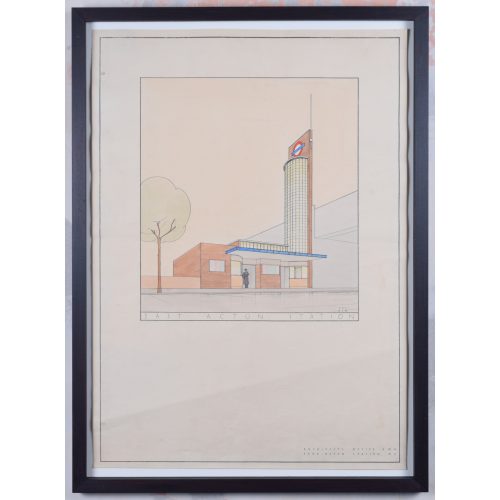
Brian Bannatyne Lewis (1906 - 1991)
East Acton Station (1938)
Pen, ink and watercolour 70 x 50 cm Initialled and dated 28 2 38. A 1938 design for the new East Acton tube station, commissioned by the Great Western Railway (GWR) for its proposed western extension to the Central Line. The design's Art Deco lettering befits London Transport's aesthetic in the 1930s. Lewis brings his designs to life by including smartly-dressed characters entering and leaving the stations. The Central line opened in 1900, between Shepherd's Bush and Bank; it extended westwards to Ealing Broadway in 1920. Two years after the formation of London Transport in 1933, an extensive New Works Programme began, proposing a westwards extension of the line to Denham. Brian Lewis created designs for nine stations in early 1938, but the Second World War broke out before they could be built. By the time the extension had been built, Lewis was no longer chief architect of the GWR - the stations were modified and completed by Frederick Francis Charles Curtis instead. The extension to Greenford opened in 1947 and finally reached West Ruislip in 1948. Denham never actually became part of the tube line, owing to the establishment of the green belt. Brian Lewis was born in Tasmania, attended school in Melbourne, and subsequently obtained a Diploma in Architecture in 1928 from the University of Melbourne. He then moved to the UK to study at the Liverpool School of Architecture, winning scholarships in each of his three years of study to fund extensive European travel. He married a fellow Liverpool architectural student, Hilary Archer. After moving to London, he took up employment with the GWR in their architects’ office; he also lectured at a local polytechnic, and moonlighted with his wife at home on mainly residential commissions – rather different projects from the hotels and stations which GWR commissioned from him. He exhibited frequently at the Royal Academy of Arts, showing superb measured drawings of historic buildings. In the Second World War he enlisted with the Second Imperial Australian Force, serving in the Middle East, then transferred to the Royal Australian Engineers where he became a Captain. In 1943 he was sent to London to help GWR repair bomb damage. Lewis became Chief Architect of GWR in 1945 (following the retirement of the noted Percy Emerson Culverhouse), and the first Chair of Architecture at Melbourne University in 1947. He also became the consulting architect for the major buildings of the Australian National University in Canberra, producing an imaginative site plan and designing University House, which was awarded the Sulman medal in 1954. He also designed the Risdon Prison Complex in 1960. He retired in 1971 to paint watercolours and write his memoirs. Condition: generally very good; a few handling marks and two holes from filing. Handsomely framed. If you are interested, please email info@manningfineart.co.uk or call us on 07929 749056. Click here to view the other station designs in the set. -
Out of stock
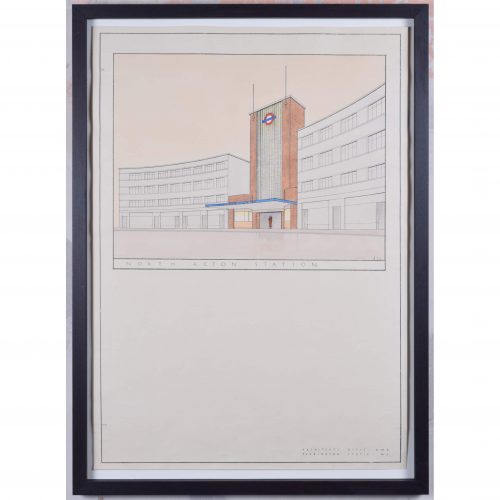
Brian Bannatyne Lewis (1906 - 1991)
North Acton Station (1938)
Pen, ink and watercolour 70 x 50 cm Initialled and dated 26 2 38. A 1938 design for the new North Acton tube station, commissioned by the Great Western Railway (GWR) for its proposed western extension to the Central Line. The design's Art Deco lettering befits London Transport's aesthetic in the 1930s. Lewis brings his designs to life by including smartly-dressed characters entering and leaving the stations. The Central line opened in 1900, between Shepherd's Bush and Bank; it extended westwards to Ealing Broadway in 1920. Two years after the formation of London Transport in 1933, an extensive New Works Programme began, proposing a westwards extension of the line to Denham. Brian Lewis created designs for nine stations in early 1938, but the Second World War broke out before they could be built. By the time the extension had been built, Lewis was no longer chief architect of the GWR - the stations were modified and completed by Frederick Francis Charles Curtis instead. The extension to Greenford opened in 1947 and finally reached West Ruislip in 1948. Denham never actually became part of the tube line, owing to the establishment of the green belt. Brian Lewis was born in Tasmania, attended school in Melbourne, and subsequently obtained a Diploma in Architecture in 1928 from the University of Melbourne. He then moved to the UK to study at the Liverpool School of Architecture, winning scholarships in each of his three years of study to fund extensive European travel. He married a fellow Liverpool architectural student, Hilary Archer. After moving to London, he took up employment with the GWR in their architects’ office; he also lectured at a local polytechnic, and moonlighted with his wife at home on mainly residential commissions – rather different projects from the hotels and stations which GWR commissioned from him. He exhibited frequently at the Royal Academy of Arts, showing superb measured drawings of historic buildings. In the Second World War he enlisted with the Second Imperial Australian Force, serving in the Middle East, then transferred to the Royal Australian Engineers where he became a Captain. In 1943 he was sent to London to help GWR repair bomb damage. Lewis became Chief Architect of GWR in 1945 (following the retirement of the noted Percy Emerson Culverhouse), and the first Chair of Architecture at Melbourne University in 1947. He also became the consulting architect for the major buildings of the Australian National University in Canberra, producing an imaginative site plan and designing University House, which was awarded the Sulman medal in 1954. He also designed the Risdon Prison Complex in 1960. He retired in 1971 to paint watercolours and write his memoirs. Condition: generally very good; a few handling marks and two holes from filing. Handsomely framed. If you are interested, please email info@manningfineart.co.uk or call us on 07929 749056. Click here to view the other station designs in the set. -
Out of stock
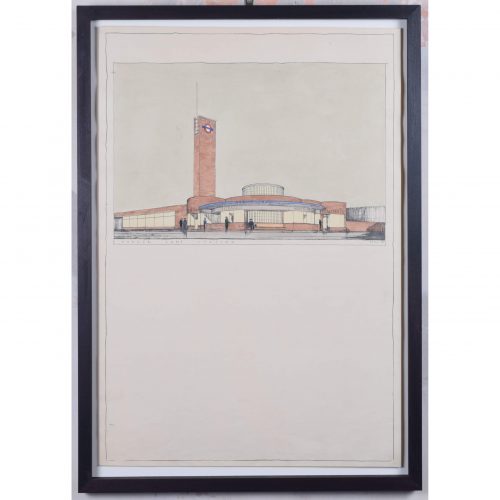
Brian Bannatyne Lewis (1906 - 1991)
Hanger Lane Station (1938)
Pen, ink and watercolour 70 x 50 cm Inscribed 'BB Lewis' lower right. A 1938 design for the new Hanger Lane tube station, commissioned by the Great Western Railway (GWR) for its proposed western extension to the Central Line. The design's Art Deco lettering befits London Transport's aesthetic in the 1930s. Lewis brings his designs to life by including smartly-dressed characters entering and leaving the stations. The Central line opened in 1900, between Shepherd's Bush and Bank; it extended westwards to Ealing Broadway in 1920. Two years after the formation of London Transport in 1933, an extensive New Works Programme began, proposing a westwards extension of the line to Denham. Brian Lewis created designs for nine stations in early 1938, but the Second World War broke out before they could be built. By the time the extension had been built, Lewis was no longer chief architect of the GWR - the stations were modified and completed by Frederick Francis Charles Curtis instead. The extension to Greenford opened in 1947 and finally reached West Ruislip in 1948. Denham never actually became part of the tube line, owing to the establishment of the green belt. Brian Lewis was born in Tasmania, attended school in Melbourne, and subsequently obtained a Diploma in Architecture in 1928 from the University of Melbourne. He then moved to the UK to study at the Liverpool School of Architecture, winning scholarships in each of his three years of study to fund extensive European travel. He married a fellow Liverpool architectural student, Hilary Archer. After moving to London, he took up employment with the GWR in their architects’ office; he also lectured at a local polytechnic, and moonlighted with his wife at home on mainly residential commissions – rather different projects from the hotels and stations which GWR commissioned from him. He exhibited frequently at the Royal Academy of Arts, showing superb measured drawings of historic buildings. In the Second World War he enlisted with the Second Imperial Australian Force, serving in the Middle East, then transferred to the Royal Australian Engineers where he became a Captain. In 1943 he was sent to London to help GWR repair bomb damage. Lewis became Chief Architect of GWR in 1945 (following the retirement of the noted Percy Emerson Culverhouse), and the first Chair of Architecture at Melbourne University in 1947. He also became the consulting architect for the major buildings of the Australian National University in Canberra, producing an imaginative site plan and designing University House, which was awarded the Sulman medal in 1954. He also designed the Risdon Prison Complex in 1960. He retired in 1971 to paint watercolours and write his memoirs. Condition: generally very good; a few handling marks and two holes from filing. Handsomely framed. If you are interested, please email info@manningfineart.co.uk or call us on 07929 749056. Click here to view the other station designs in the set. -
Out of stock
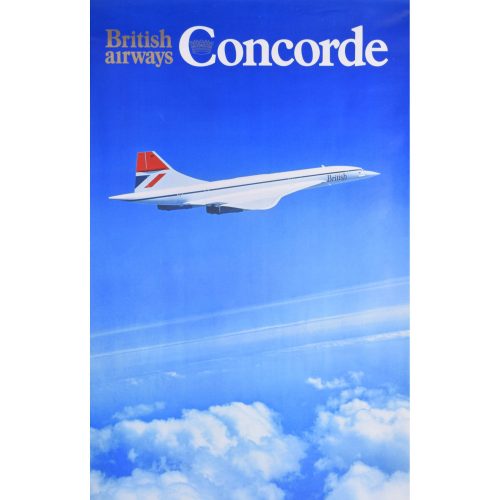
Concorde
Original vintage poster 102 x 64 cm A striking poster advertising the glamorous Concorde aircraft for British Airways. Concorde entered service in 1976 with Air France from Paris-Roissy and British Airways from London Heathrow. Condition: very good. If you are interested, please email info@manningfineart.co.uk or call us on 07929 749056. -
Out of stock
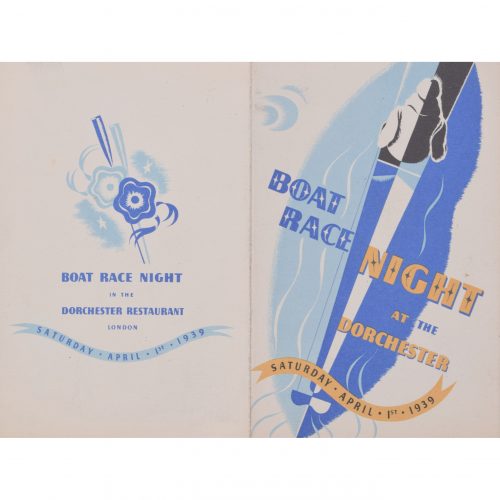
Brownbridge (flourished 1930s - 1940s)
Boat Race at the Dorchester (1939)
Lithographic brochure 15 x 19.5 cm From a small archive of works by Brownbridge, a member of the Society of Industrial Artists. A design for a poster advertising the Dorchester's dinner after the Oxford and Cambridge Boat Race. The artist has built his design around dark and light blues, to represent the colours of Oxford and Cambridge respectively. Brownbridge's design is marvellously 1930s, from the boldly decorative typeface to the whimsically glamorous guests and their waiters floating below the invitation. Boat Race dinners in London are rather different today; at any rate, prices are not normally advertised as 'excluding Wines and Cigars'. Society of Industrial Artists correspondance (photographed above) is not included; please enquire separately. Condition: generally very good. If you are interested, please email info@manningfineart.co.uk or call us on 07929 749056. Click here for other designs by Brownbridge. -
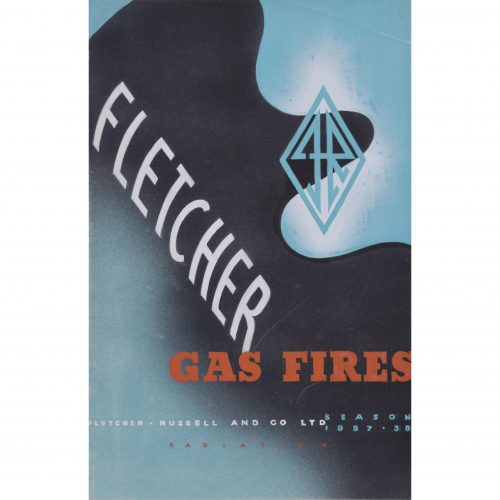
Brownbridge (flourished 1930s - 1940s)
Fletcher Gas Fires brochure design (1937)
Lithographic brochure 21.5 x 14 cm From a small archive of works by Brownbridge, a member of the Society of Industrial Artists. An original gouache design for a brochure advertising Fletcher Russell and Co. gas fires. The futuristic style of the boldly blue-, black-, and orange-coloured poster, as well as the dynamic diamond-shaped badge containing the initials F and R (for Fletcher and Russell) combine to make this a highly modern piece of 1930s design. Society of Industrial Artists correspondance (photographed above) is not included; please enquire separately. Condition: generally very good; gentle crease to top right corner. If you are interested, please email info@manningfineart.co.uk or call us on 07929 749056. Click here for other designs by Brownbridge. -
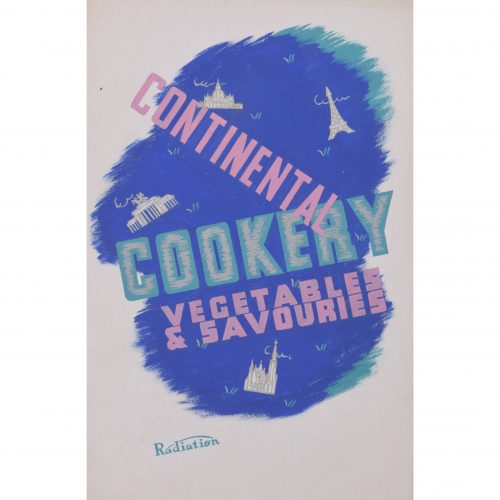
Brownbridge (flourished 1930s - 1940s)
Continental Cookery Radiation cooker brochure design
Gouache 21.5 x 14 cm From a small archive of works by Brownbridge, a member of the Society of Industrial Artists. A beautiful original gouache design for a brochure of continental recipes, created to advertise Radiation cookers (innovative gas cookers which were sold in Britain in the 1920s and 1930s). Brownbridge's brightly-coloured design includes boldly slanted text in pink and turquoise, set over a deep blue background; he also highlights architectural gems of Europe, such as the Eiffel Tower. By cooking with a Radiation cooker, the cover suggests, you too can experience the cultural and culinary delights of Europe from the comfort of your own home. Society of Industrial Artists correspondance (photographed above) is not included; please enquire separately. Condition: generally very good. If you are interested, please email info@manningfineart.co.uk or call us on 07929 749056. Click here for other designs by Brownbridge. -

Brownbridge (flourished 1930s - 1940s)
Achievement Radiation gas cookers brochure design
Pen and collage 21.5 x 14 cm From a small archive of works by Brownbridge, a member of the Society of Industrial Artists. Brownbridge's bold design advertises Radiation cookers (innovative gas cookers which were sold in Britain in the 1920s and 1930s). Shiny white against a dark background, the Radiation cooker seems impossibly glamorous and inviting. Society of Industrial Artists correspondance (photographed above) is not included; please enquire separately. Condition: generally very good. If you are interested, please email info@manningfineart.co.uk or call us on 07929 749056. Click here for other designs by Brownbridge. -
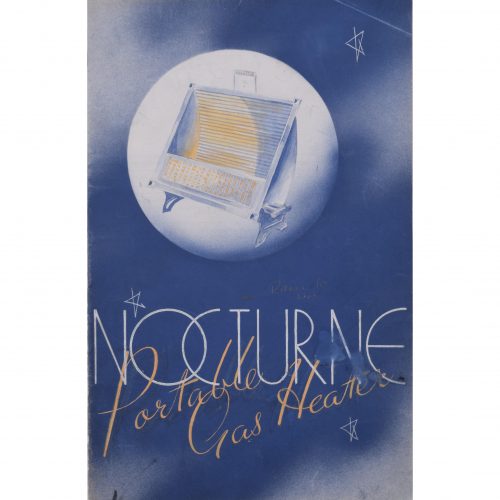
Brownbridge (flourished 1930s - 1940s)
Nocturne Portable Gas Heater brochure design
Gouache and mixed media art 21.5 x 14 cm From a small archive of works by Brownbridge, a member of the Society of Industrial Artists. A marvellous gouache design for a brochure advertising the Nocturne portable gas heater. The art deco text surrounded by stars and image of the innovative gas heater superimposed on the moon combine to make this a thoroughly modern piece of 1930s design. Society of Industrial Artists correspondance (photographed above) is not included; please enquire separately. Condition: generally very good; some damage to reverse. If you are interested, please email info@manningfineart.co.uk or call us on 07929 749056. Click here for other designs by Brownbridge. -
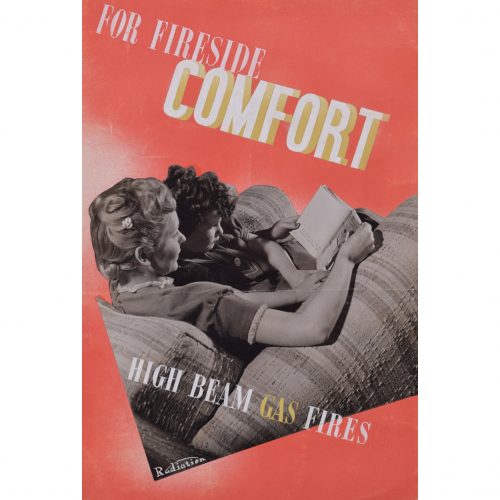
Brownbridge (flourished 1930s - 1940s)
For Fireside Comfort, High Beam Gas Fires brochure design
Gouache, mixed media art, and collage 21.5 x 14 cm From a small archive of works by Brownbridge, a member of the Society of Industrial Artists. A design for a brochure advertising Radiation's high beam gas fires. Brownbridge's design combines a photograph of a mother and child with hand-painted text; the red and yellow colour palette project warmth and cosiness. The mother's hair is fantastically 1930s, and she reads a copy of 'Patsy Ann: Her Happy Times' by Mona Reed King (first published in 1935) to her son. Society of Industrial Artists correspondance (photographed above) is not included; please enquire separately. Condition: generally very good; lacking 'The Serene' collaged photograph. If you are interested, please email info@manningfineart.co.uk or call us on 07929 749056. Click here for other designs by Brownbridge. -
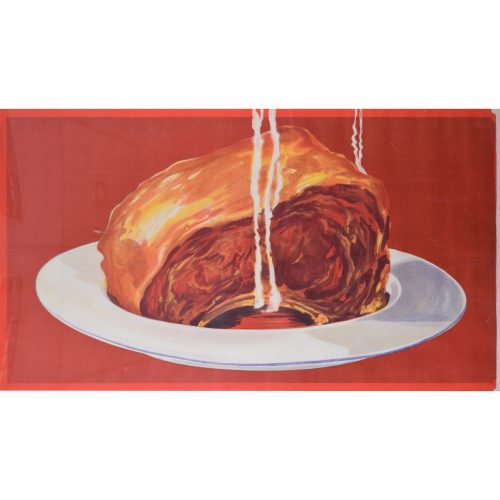
Rib of Beef
Original vintage poster 56 x 97 cm An original poster produced by Bisto to to advertise their gravy granules. With no lettering, the deep red poster is a bold and compelling advert which relies on the public's understanding that Bisto is the only choice. Condition: backed to linen, very good; a few repaired tears to right side. If you are interested, please email info@manningfineart.co.uk or call us on 07929 749056. Click here for other original vintage posters. -
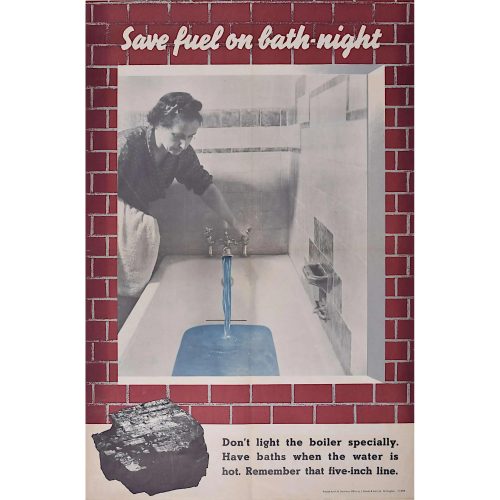
Beverley Pick (1916 - 1995/6)
Save Fuel on Bath Night (circa 1944)
Original vintage poster 30 x 20 in Poster published for the Ministry of Information. In this series of ten posters, "Mrs Housewife" shows us how to save fuel at home as part of the Home Front war effort. The character's hair and dress, and the style of the bath (with a line drawn on it to remind bathers to use no more than five inches of water), are fantastically 1940s. Beverley Pick was born in the Netherlands. He spent the Second World War designing posters for the Ministry of Information, many of them in a highly modern photographic style. He was a member of the Society of Industrial Artists, and created varied posters for commercial and industrial organisations, including the British Overseas Airways Corporation and British European Airways, after the war. Condition: folds as issued; slight edge wear. Otherwise generally very good. If you are interested, please email info@manningfineart.co.uk or call us on 07929 749056. Click here for other original vintage Home Front posters. -
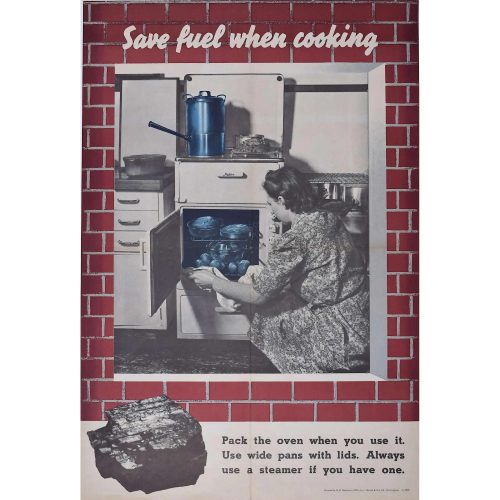
Beverley Pick (1916 - 1995/6)
Save Fuel when Cooking (circa 1944)
Original vintage poster 30 x 20 in Poster published for the Ministry of Information. In this series of ten posters, "Mrs Housewife" shows us how to save fuel at home as part of the Home Front war effort. The character's hair and dress, and the style of her kitchen, are fantastically 1940s. Beverley Pick was born in the Netherlands. He spent the Second World War designing posters for the Ministry of Information, many of them in a highly modern photographic style. He was a member of the Society of Industrial Artists, and created varied posters for commercial and industrial organisations, including the British Overseas Airways Corporation and British European Airways, after the war. Condition: folds as issued; slight edge wear. Otherwise generally very good. If you are interested, please email info@manningfineart.co.uk or call us on 07929 749056. Click here for other original vintage Home Front posters. -

Beverley Pick (1916 - 1995/6)
Save Fuel when Ironing (circa 1944)
Original vintage poster 30 x 20 in Poster published for the Ministry of Information. In this series of ten posters, "Mrs Housewife" shows us how to save fuel at home as part of the Home Front war effort. The character's hair, clothes, and tiny iron are fantastically 1940s. Beverley Pick was born in the Netherlands. He spent the Second World War designing posters for the Ministry of Information, many of them in a highly modern photographic style. He was a member of the Society of Industrial Artists, and created varied posters for commercial and industrial organisations, including the British Overseas Airways Corporation and British European Airways, after the war. Condition: folds as issued; slight edge wear. Otherwise generally very good. If you are interested, please email info@manningfineart.co.uk or call us on 07929 749056. Click here for other original vintage Home Front posters. -
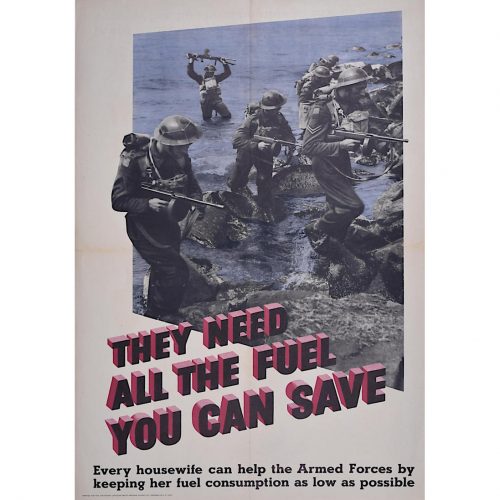
Beverley Pick (1916 - 1995/6)
They Need All the Fuel You Can Save (circa 1944)
Original vintage poster 30 x 20 in Poster published for the Ministry of Information. This series of ten posters illustrates how housewives ought to save fuel at home as part of the Home Front war effort. Here, the poster reminds us that less fuel used at home means more fuel available for the Armed Forces (pictured here during the D-Day landings, disembarking from a landing craft). Beverley Pick was born in the Netherlands. He spent the Second World War designing posters for the Ministry of Information, many of them in a highly modern photographic style. He was a member of the Society of Industrial Artists, and created varied posters for commercial and industrial organisations, including the British Overseas Airways Corporation and British European Airways, after the war. Condition: folds as issued; slight edge wear. Otherwise generally very good. If you are interested, please email info@manningfineart.co.uk or call us on 07929 749056. Click here for other original vintage Home Front posters. -
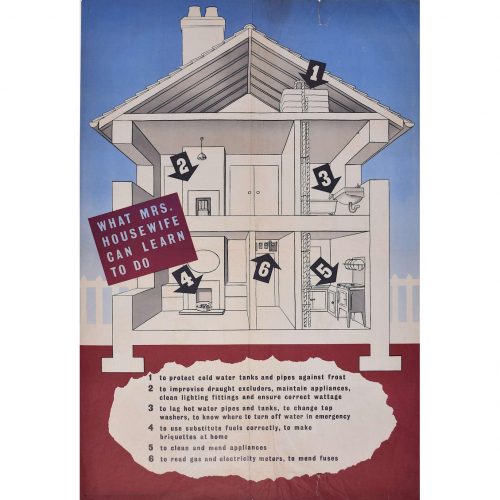
Beverley Pick (1916 - 1995/6)
What Mrs Housewife Can Learn To Do (circa 1944)
Original vintage poster 30 x 20 in Poster published for the Ministry of Information. This series of ten posters illustrates how housewives ought to save fuel at home as part of the Home Front war effort. Here, we are presented with a list of six tasks, including insulating water tanks and reading electricity meters, which a housewife should learn to do. Beverley Pick was born in the Netherlands. He spent the Second World War designing posters for the Ministry of Information, many of them in a highly modern photographic style. He was a member of the Society of Industrial Artists, and created varied posters for commercial and industrial organisations, including the British Overseas Airways Corporation and British European Airways, after the war. Condition: folds as issued, slight edge wear, and short closed edge tear. Otherwise generally very good. If you are interested, please email info@manningfineart.co.uk or call us on 07929 749056. Click here for other original vintage Home Front posters. -
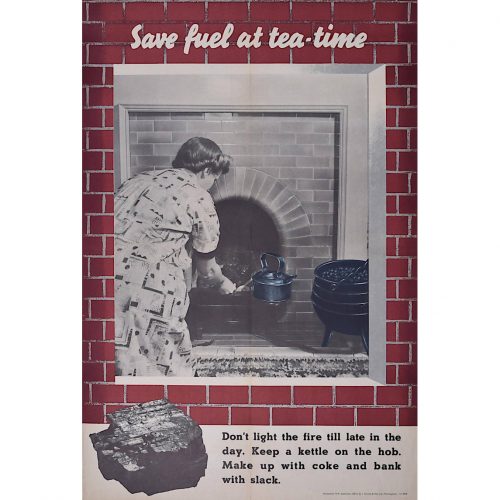
Beverley Pick (1916 - 1995/6)
Save Fuel at Tea Time (circa 1944)
Original vintage poster 30 x 20 in Poster published for the Ministry of Information. In this series of ten posters, "Mrs Housewife" shows us how to save fuel at home as part of the Home Front war effort. The character's hair and dress are fantastically 1940s. Beverley Pick was born in the Netherlands. He spent the Second World War designing posters for the Ministry of Information, many of them in a highly modern photographic style. He was a member of the Society of Industrial Artists, and created varied posters for commercial and industrial organisations, including the British Overseas Airways Corporation and British European Airways, after the war. Condition: folds as issued; slight edge wear. Otherwise generally very good. If you are interested, please email info@manningfineart.co.uk or call us on 07929 749056. Click here for other original vintage Home Front posters. -
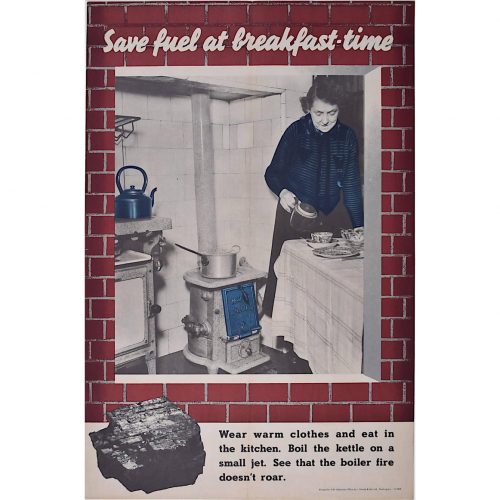
Beverley Pick (1916 - 1995/6)
Save Fuel at Breakfast Time (circa 1944)
Original vintage poster 30 x 20 in Poster published for the Ministry of Information. In this series of ten posters, "Mrs Housewife" shows us how to save fuel at home as part of the Home Front war effort. The character's kitchen, kettle, and cooking accoutrements are fantastically 1940s. Beverley Pick was born in the Netherlands. He spent the Second World War designing posters for the Ministry of Information, many of them in a highly modern photographic style. He was a member of the Society of Industrial Artists, and created varied posters for commercial and industrial organisations, including the British Overseas Airways Corporation and British European Airways, after the war. Condition: folds as issued; slight edge wear. Otherwise generally very good. If you are interested, please email info@manningfineart.co.uk or call us on 07929 749056. Click here for other original vintage Home Front posters. -
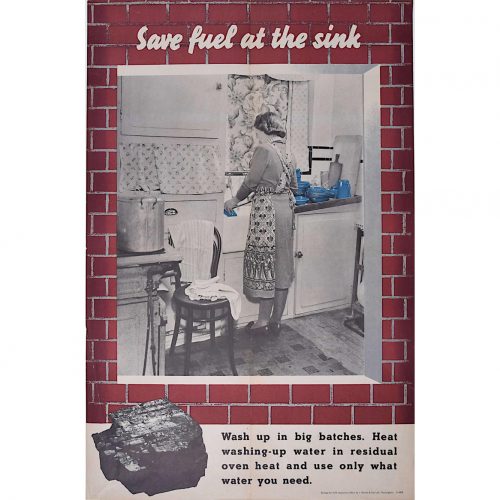
Beverley Pick (1916 - 1995/6)
Save Fuel at the Sink (circa 1944)
Original vintage poster 30 x 20 in Poster published for the Ministry of Information. In this series of ten posters, "Mrs Housewife" shows us how to save fuel at home as part of the Home Front war effort. The character's hair and dress, and the style of her kitchen, are fantastically 1940s. Beverley Pick was born in the Netherlands. He spent the Second World War designing posters for the Ministry of Information, many of them in a highly modern photographic style. He was a member of the Society of Industrial Artists, and created varied posters for commercial and industrial organisations, including the British Overseas Airways Corporation and British European Airways, after the war. Condition: folds as issued; slight edge wear. Otherwise generally very good. If you are interested, please email info@manningfineart.co.uk or call us on 07929 749056. Click here for other original vintage Home Front posters. -
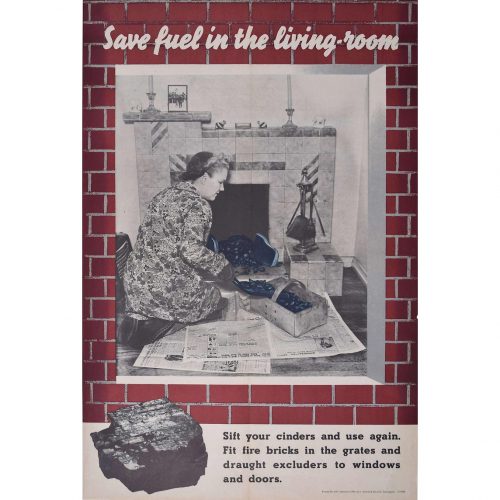
Beverley Pick (1916 - 1995/6)
Save Fuel in the Living Room (circa 1944)
Original vintage poster 30 x 20 in Poster published for the Ministry of Information. In this series of ten posters, "Mrs Housewife" shows us how to save fuel at home as part of the Home Front war effort. The character's hair and dress are fantastically 1940s. Beverley Pick was born in the Netherlands. He spent the Second World War designing posters for the Ministry of Information, many of them in a highly modern photographic style. He was a member of the Society of Industrial Artists, and created varied posters for commercial and industrial organisations, including the British Overseas Airways Corporation and British European Airways, after the war. Condition: folds as issued; slight edge wear. Otherwise generally very good. If you are interested, please email info@manningfineart.co.uk or call us on 07929 749056. Click here for other original vintage Home Front posters. -
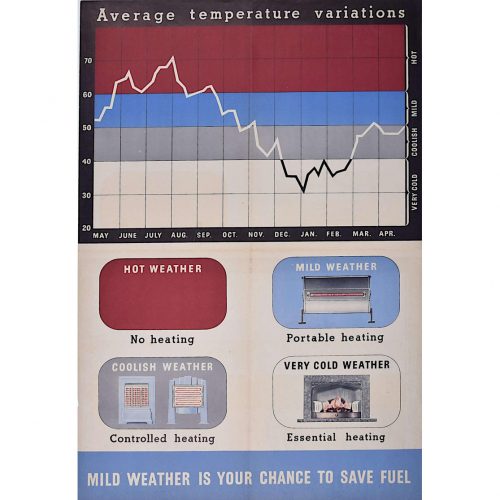
Beverley Pick (1916 - 1995/6)
Mild Weather is Your Chance to Save Fuel (circa 1944)
Original vintage poster 30 x 20 in Poster published for the Ministry of Information. In this series of ten posters, "Mrs Housewife" shows us how to save fuel at home as part of the Home Front war effort. This poster advises that less heating, and thus less fuel, is required during mild weather. Beverley Pick was born in the Netherlands. He spent the Second World War designing posters for the Ministry of Information, many of them in a highly modern photographic style. He was a member of the Society of Industrial Artists, and created varied posters for commercial and industrial organisations, including the British Overseas Airways Corporation and British European Airways, after the war. Condition: folds as issued; slight edge wear. Otherwise generally very good. If you are interested, please email info@manningfineart.co.uk or call us on 07929 749056. Click here for other original vintage Home Front posters. -
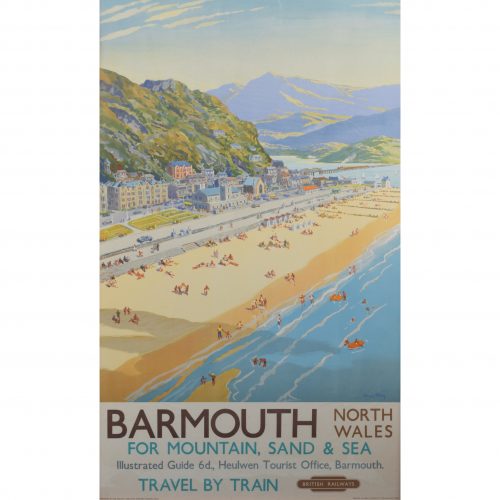
Harry Arthur Riley (1895 - 1966)
Barmouth, North Wales, for Mountain, Sand & Sea
Original vintage poster 100 x 60 cm Riley's vintage poster extols the virtues of visiting sunny Barmouth - the scene depicts dozens of attractively (if perhaps unrealistically) tanned holidaymakers, a bright blue sea, and a pretty coastal town. The poster was part of a series produced for British Railways, designed to encourage rail travel to beauty spots across Britain. Principally known as a commercial artist, Harry Riley RI’s iconic poster designs of the 1920s - 1960s and his bright, joyful and idyllic depictions of British seaside holiday destinations, such as Morecambe, Plymouth, Weston-Super-Mare and Ilfracombe, were used to advertise the British rail network and have come to define Post-War British leisure and travel. He was also known for this work with airliners such as BOAC and Qantas. Although not an easily identifiable name within the echelons of the mid-20th century commercial art scene, Riley’s works pay testament to a highly skilled and prolific artist whose visual style fittingly captures the idealistic and amber-tinted vision of early 1960s glamour that the era’s commercial and travel sectors strove to embody. Harry Riley studied at St Martin's School of Art and was soon commissioned to produce commercial art and poster designs for companies such as Selfridges and Fortnum & Mason. He became a member of the Royal Institute of Painters in Watercolour and worked as a cartoonist for the Daily Mail, later becoming President of the London Sketch Club. The bright and bold style of his art for British Railways has become instantly recognisable today and is an illustration of travel, leisure, and idealism in post-war Britain. Condition: colours good. Backed to board. If you are interested, please email info@manningfineart.co.uk or call us on 07929 749056. Click here for other original vintage travel posters.

